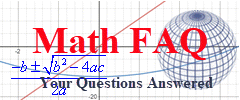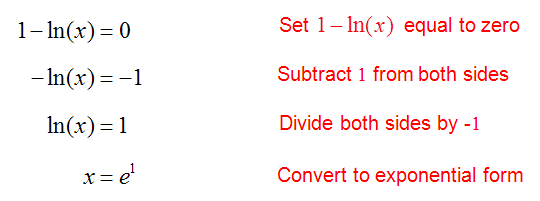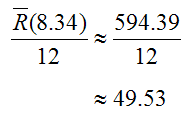How do you find the absolute extrema of a function?
The absolute extrema of a function is the highest or lowest point over which a function is defined. In general, a function may or may not have an absolute maximum or absolute minimum. However, under certain conditions a function will automatically have absolute extrema. The Extreme Value Theorem guarantees that a continuous function defined over a closed interval will have both an absolute maximum and an absolute minimum. These extrema will occur at the critical values or at the end points on the closed interval.
To find the absolute extrema from these possibilities, we must determine which of these values yields the highest and lowest values of the function. This is done by testing each critical value and the endpoints in the function. The highest value of the function is the absolute maximum and the lowest value is the absolute minimum.
Strategy for Finding Absolute Extrema
To find the absolute extrema on a continuous function f defined over a closed interval,
- Find all critical values for the function f on the open interval.
- Evaluate each critical value in the function f.
- Evaluate each endpoint of the closed interval in the function f.
- The largest function value from steps 2 and 3 is the absolute maximum and the smallest function value from steps 2 and 3 is the absolute minimum.
Notice that the absolute extrema are the function values, not the critical values or endpoints. However, the absolute extrema occur at points on the graph given by an ordered pair.
Example 9 Find the Absolute Extrema of a Function
Find the absolute maximum and absolute minimum of the function
on the closed interval [1, 6].
Solution This function is a polynomial so it is continuous not only on the closed interval [1, 6], but everywhere. The absolute extrema of a continuous function over a closed interval will occur at a critical value in the interval or at the endpoints. We can located the critical values of this function from the derivative,
Since f (x) is a polynomial and defined everywhere, the only critical values are due to where the derivative is equal to zero. Set f ′(x) equal to zero and solve for x:
One of these critical values, x = 0, is not in the interval so we can ignore it.
The other critical point at x = 4 and endpoints at x = 1 and x = 6 are substituted into f (x) in order to find the highest and lowest points on the graph.
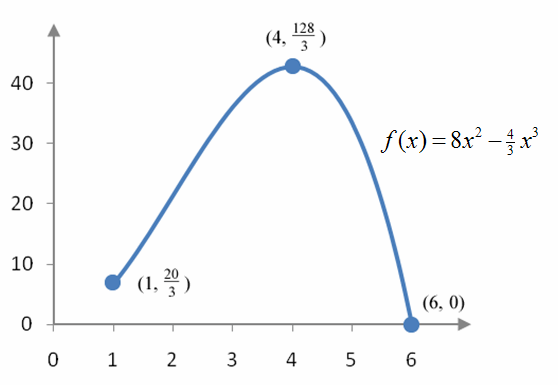
Example 10 Find the Absolute Extrema of a Function
Find the absolute maximum and absolute minimum of the function
on the closed interval [2, 10].
Solution The natural logarithm is continuous over [2, 10] and the denominator is equal to zero outside of this interval. This means the quotient is continuous over [2, 10]. Therefore the absolute extrema are located at the critical values or the endpoints of the interval. To find the critical values, calculate the derivative with the quotient rule.
The numerator, denominator and their derivatives are
The critical values of a function are where the derivative is equal to zero or undefined. For a fraction like this one, the derivative is undefined where the denominator is equal to zero. This occurs when x = 0 . However, this value is outside of the interval [2, 10] so it can be ignored.
To find where the derivative is equal to zero, set the numerator of f ′(x) equal to zero and solve for x:
This critical value is at x = e. This value is approximately 2.72 and is in the interval [2,10].
To find the absolute extrema, we need to substitute the critical value at x = e and the endpoints of the interval at x = 2 and 10 into f (x).
Using the function f (x), we get the location of each ordered pair at the critical number and endpoints.
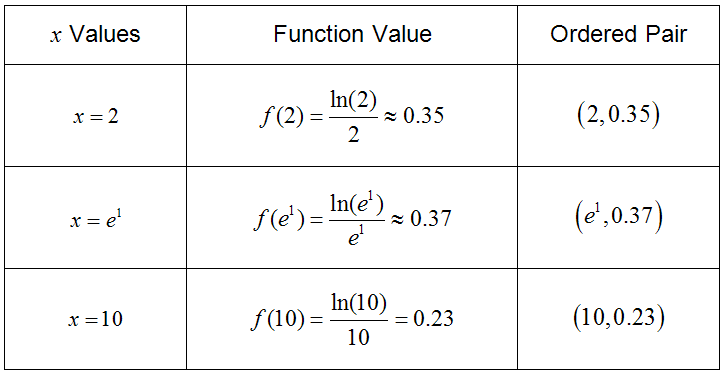
Example 11 Find the Absolute Extrema of a Function
Verizon Wireless charges each customer a monthly charge for service on its wireless network. This charge is recorded as service revenue in corporate reports. The average annual service revenue per customer (in dollars) at Verizon Wireless from 2004 to 2009 can be modeled by the function
where t is the number of years since 2000.
(Source Verizon Annual Reports 2004 through 2009)
a. Over the period 2004 to 2009, when was the average annual service revenue per customer highest?
Solution Since this function is defined from 2004 to 2009, the variable t is defined on the closed interval [4, 9]. The average annual service revenue per customer is highest at the absolute maximum on this interval.
The derivative of R(t) is found using the basic rules for taking derivatives and the Power Rule for Derivatives:
Critical values for this polynomial are found by setting this derivative equal to zero and solving for the variable:
Both of these critical values are in the interval [4, 9].
Evaluate R(t) at the two critical values and the endpoints to find the absolute maximum.
The average annual service revenue per customer is highest at t ≈ 8.34 or in the year 2008.
b. When the average annual service revenue per customer was highest, how much was each customer paying each month?
Solution The average annual service revenue per customer was highest at t ≈ 8.34 at a value of 594.39 dollars per customer. However, this is the annual service revenue per customer. To get the monthly service revenue per customer at this time, divide this value by 12 to give
or 49.53 dollars per month for each customer.
